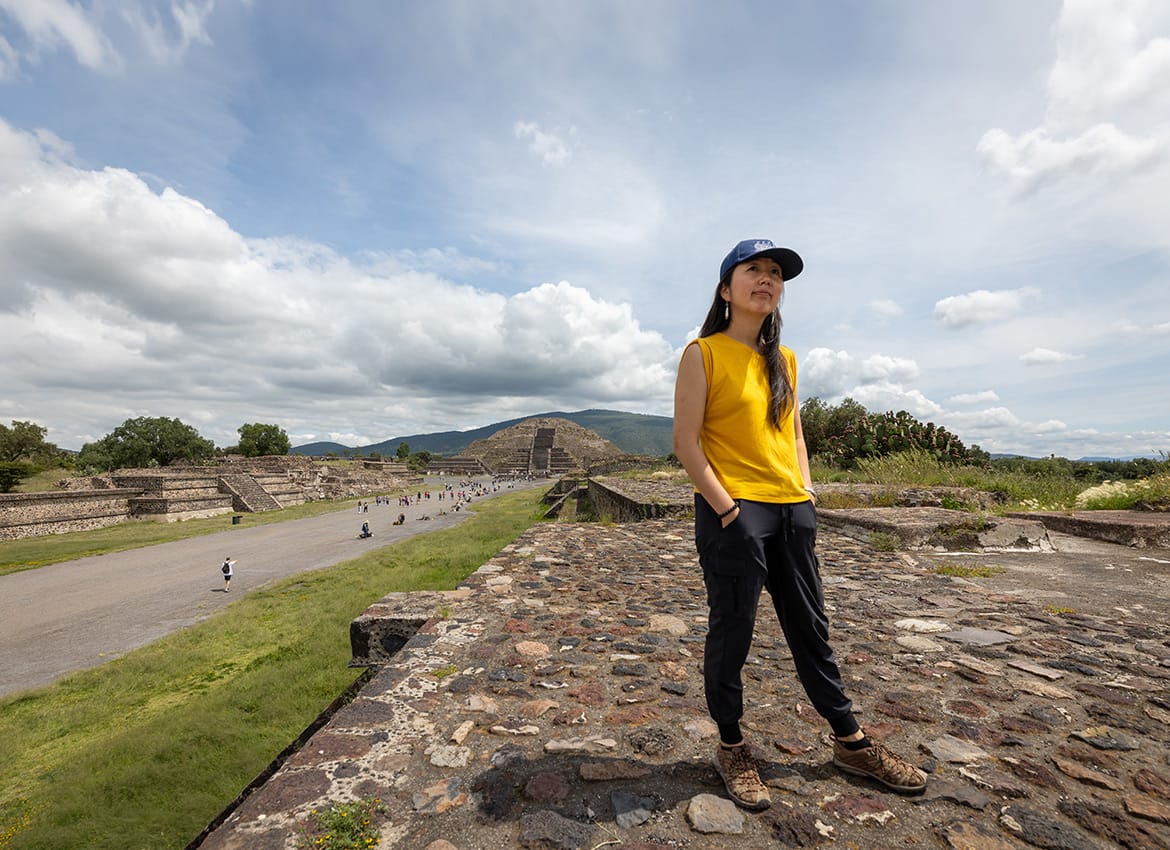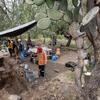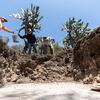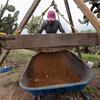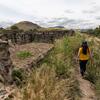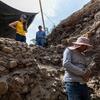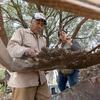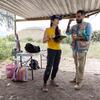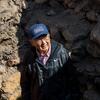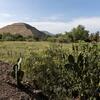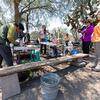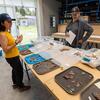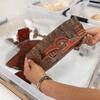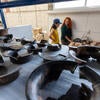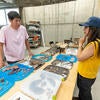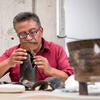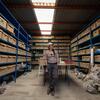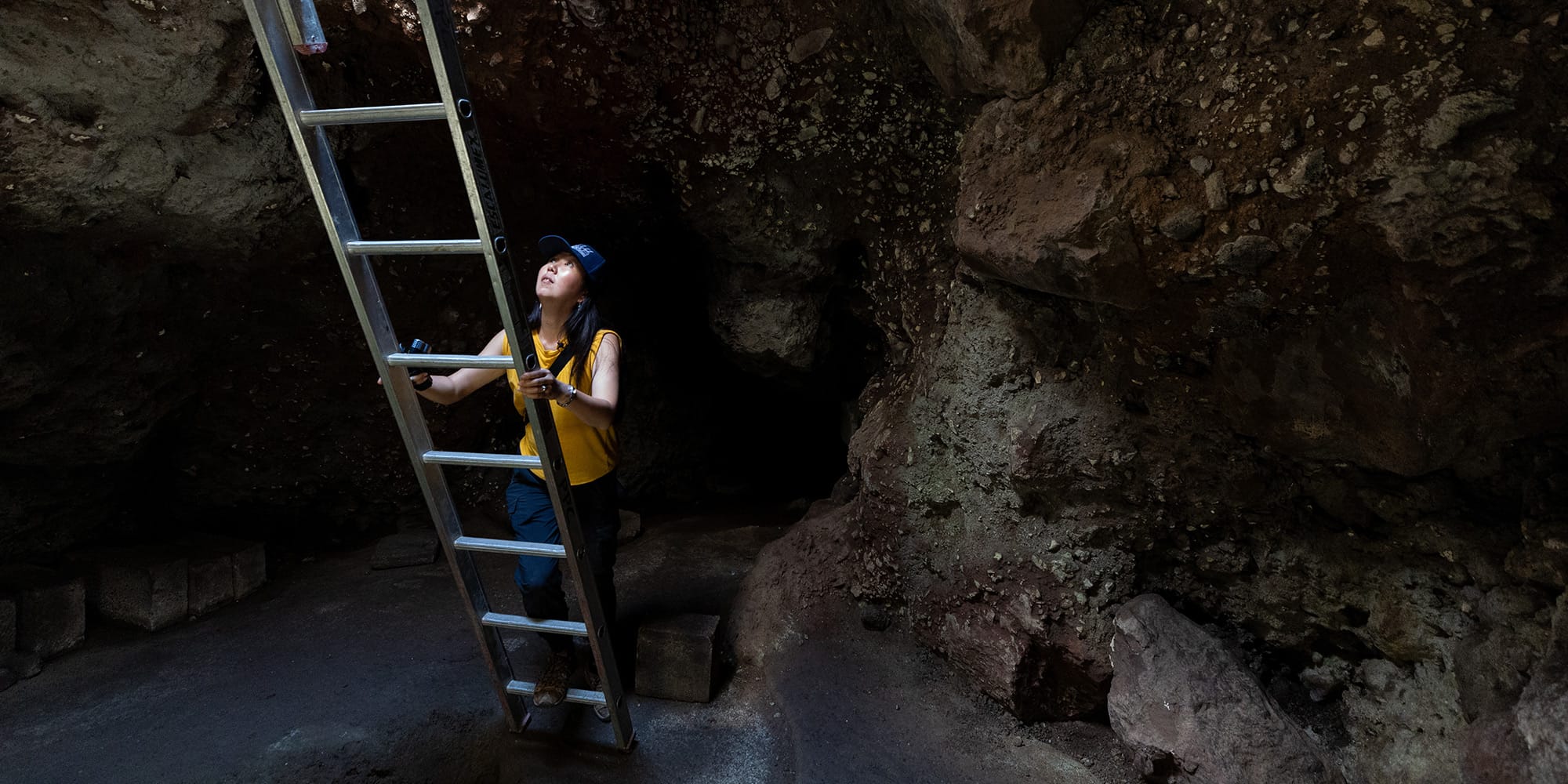Unearthing the Mysteries of Teotihuacan
Teotihuacan was a dynamic and economic powerhouse in central Mexico, dating back more than 1,900 years. Now archaeologists, led by UCR’s Nawa Sugiyama, are trying to find out who governed the megacity and explain their most recent discovery: the burning of the once great metropolis.
By Sandra Baltazar Martínez | Photos by Stan Lim
“T here was a violent event here,” said anthropological archaeologist Nawa Sugiyama on a warm August morning, walking from the excavation site south of the Pyramid of the Moon — down narrow trails, past huisache trees, and around small mounds of dirt built by fire ants. “Now we must find out why.”
Hidden between fields of cacti and desert brush, Sugiyama and teams of UCR graduate students, Mexican anthropologists, and community laborers have spent several summers in central Mexico unearthing the mysteries of Teotihuacan, one of the first megacities of the Western Hemisphere dating back more than 1,900 years. Once a dynamic and economic powerhouse, Teotihuacan thrived between 100 B.C. and 650 A.D., more than 1,000 years before the eminent Aztec civilization settled in. At its height, 100,000 people inhabited Teotihuacan.
Now a UNESCO World Heritage site, the ruins of the ancient city lie about 30 miles northeast of Mexico City and are the country’s most visited archaeological site, seeing millions of tourists each year. Even so, only about 3% of Teotihuacan has been explored by archaeologists thus far, primarily due to funding constraints, Sugiyama said. The discovery of every structure, every piece of fragmented pottery, jade, or animal bone, helps explain the life and governance of the once great metropolis.
One of the biggest discoveries yielded by Sugiyama and her team’s excavations this past summer was evidence of a great fire. Charred walls and carbonized matter prompted many questions: What or who caused the fire? Was it the result of war? Arson? And was this mysterious fire the cause of Teotihuacan’s collapse after thriving for centuries?
A Deep History
Sugiyama, an assistant professor of anthropology at UC Riverside, was one of the principal investigators on the team of archaeologists who started the Plaza of the Columns Complex research project in Teotihuacan in 2015. The project focuses on excavating areas in the Plaza of the Columns and the Plaza North of the Sun Pyramid — two largely unexplored spaces that likely hold answers to questions about cultural and religious rituals as well as economic and political governance.
Specializing in zooarchaeology, one of Sugiyama’s focuses is human-animal on interactions. In 2018, along with various animal remains and thousands of ceramic shards, the team excavated the complete skeletal remains of a spider monkey dating back 1,700 years. A significant archaeological discovery, the spider monkey represents the earliest evidence of primate captivity, translocation, and gift diplomacy between Teotihuacan and the Maya elite.
Putting pieces together and bringing them to life is part of the joy Sugiyama finds as an archaeologist, and her personal connection to the region runs deep. Mexico is Sugiyama’s birthplace and where her parents formed their respective careers. Her first name, Nawa, is the Japanese version of Nahuatl, the native language of the Aztecs, and was chosen by her mother, Kumiko, who trained in Nahuatl history. She even grew up around Teotihuacan’s excavation sites, watching her father, Saburo Sugiyama, work alongside other renowned archaeologists and anthropologists. Saburo, a research professor at Arizona State University and a professor at Aichi Prefectural University in Japan, began his work in Teotihuacan as a surveyor in 1980 with Mexico’s Instituto Nacional de Antropología e Historia (INAH), the entity charged with overseeing research and conservation of the country’s archaeological, historical, and paleontological heritage.
“It’s such an honor to be here, conducting research in the pyramids I once ran around as a kid alongside my father,” Sugiyama said. “It’s a place that feels like home.”
Now, Sugiyama shares Teotihuacan with her own 2-year-old child, Kai Orion Cebollero, who sometimes visits the excavations and observes her at work. They speak Spanish together, and he’s learned many words, including pirámide (pyramid) and ¡viva México! (long live Mexico!).
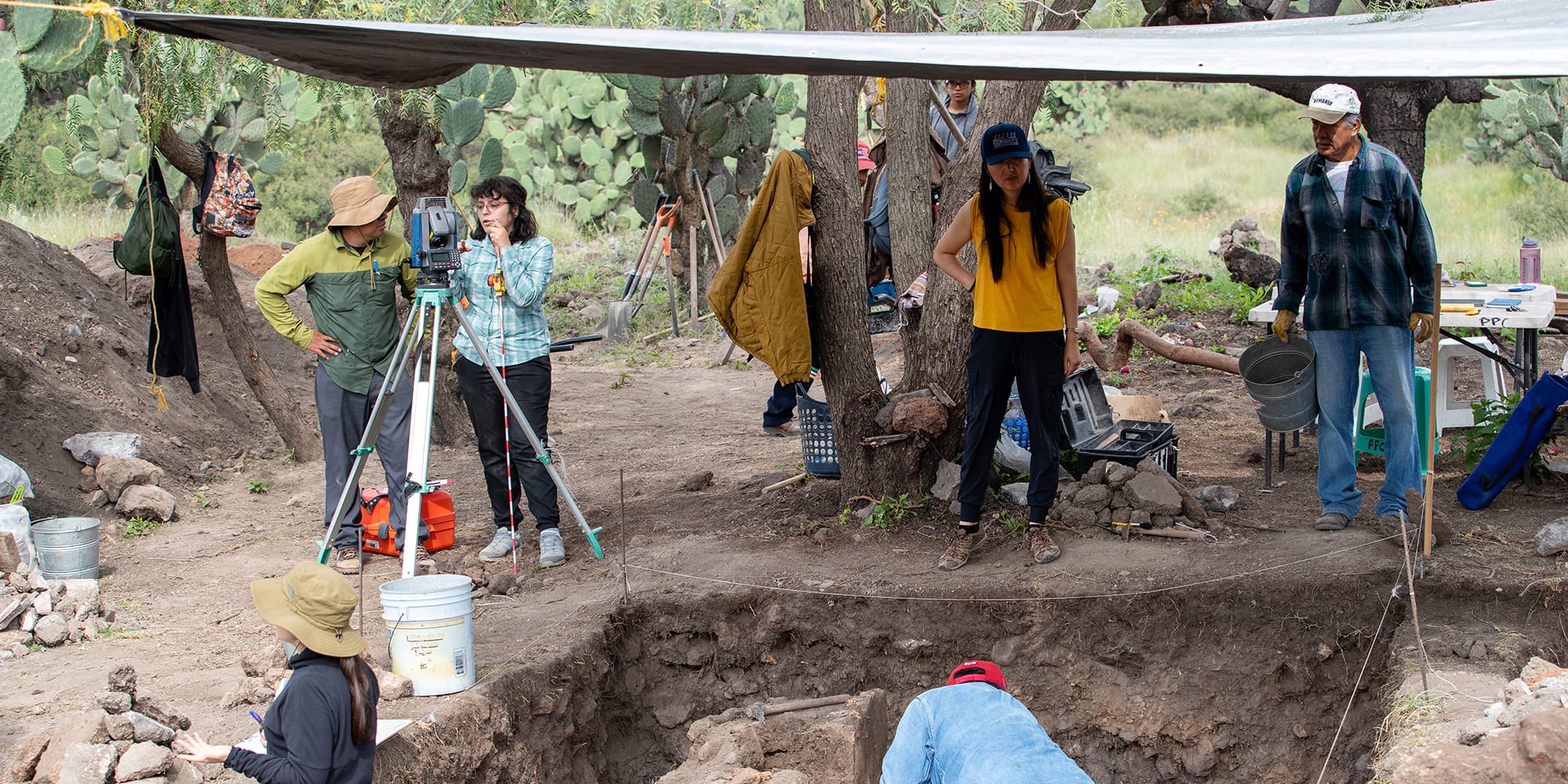
Digging In
Excavating Teotihuacan’s central civic-administrative complex in the ceremonial core of the pre-Hispanic metropolis will help Sugiyama understand the city’s occupancy and layout. Teotihuacan’s main corridor, called Calzada de los Muertos, once led visitors through three main structures: the Quetzalcoatl Temple, located on the far south of the corridor, and the pyramids of the Sun and the Moon. The structures are surrounded by smaller monuments that stand about 30 feet high and shield from the sun the fields where Sugiyama and the teams excavate.
Along the main corridor, a setup comparable to a city hall, are structures built with sloping walls — called talud — and vertical walls — called tablero — often decorated with painted designs. This layout is associated with the pre-Hispanic direction of the universe: four cardinal points plus a center. Housing complexes were erected behind these structures; Teotihuacan was a hierarchical society, with priests occupying the apex, followed by warrior nobility, artists, miners, and farmers. It became the capital of what historians recognize as one of the first Mexican organized states and held strong economic, trade, and political power.
“It’s such an honor to be here, conducting research in the pyramids I once ran around as a kid alongside my father. It’s a place that feels like home.” — Nawa Sugiyama
“We want to understand the government structure that existed here — we still don’t know much,” Sugiyama said. “How were decisions implemented? How was the city coordinated? Why was it so attractive to everyone?”
This past summer, Sugiyama and her team excavated five areas — deep openings found amidst green fields covered in peppercorn trees and prickly pear cactuses. Most of the pits revealed evidence of the potentially devastating fire, and discovering its effect on the city and its inhabitants is now a major goal for her team.
To help get answers, Sugiyama enlisted the on-site expertise of Thania Ibarra, a graduate student at Universidad Nacional Autónoma de México. Ibarra studies technology and architecture, specializing in pyrotechnic technology that helps identify the age of a fire, fuel source, and temperature, among other things. For the next few years, the team will use this technology and connect with experts to help decipher the cause and impact of the fire.
Along with the discovery of the fire, the five excavated areas yielded fragmented pottery, obsidian, animal bones, and other matter. One excavation uncovered living quarters with 2-to-4-foot-tall walls at least 18 inches in width, constructed primarily of gravel, lime, and tezontle — a porous, volcanic rock. A portion of two interiors walls, likely bedrooms for high-ranking occupants, were still visibly adorned with images in red and blue.
A team led by Manuel Vargas Uribe, an archaeologist at INAH’s anthropology college, Escuela Nacional de Antropología e Historia (ENAH), also discovered a festive deposit north of the Pyramid of the Sun. Vargas Uribe worked through a narrow opening 14 feet below the surface to access the roughly 3-feet-by-3-feet deposit. The initial goal was to excavate to find substructures, but the festive pit containing ceramics and bones from quail, deer, and rabbits, was a welcome surprise.
“It’s hot and a bit hard to breathe down here, but it’s worth it,” Vargas Uribe said in Spanish as he handed 20-pound metal buckets of unearthed matter to community laborers Cándido Cortés García, José Luis Rodríguez Torres, and Primo Espinoza Reyes. “This is exciting; not everyone has the privilege to be here, excavating this history.”
To remove the matter, the men formed an assembly line to tie the bucket onto a rope, hauled it up by hand, and then carried it to the team’s archaeological sifter, Eleuterio Cabrera Ortiz, who was assisted by ENAH’s Ximena Aguilar González. The four men on the team, just like those on the other excavation teams, are all from the region “because it’s important that the community feel invested and that they are part of this project,” Sugiyama said. Many are generational workers, meaning their fathers or uncles also worked in Teotihuacan on other archaeological projects.
Sugiyama has also made sure UCR graduate students have their hands in every stage of the project. Yun Ge, a fourth-year anthropology student from China; Ariel Texis Muñoz, a first-year archaeology student from Mexico; Diana Méndez, a second-year anthropology student from Guatemala; and Ryohei Takatsuchi, a sixth-year anthropology student from Japan, all contributed their knowledge and skills over the summer.
Now his third excavation experience with Sugiyama, Ge helped uncover several pits during the seven-week period. One of the main sites he worked on was a roughly 30-foot-by-30-foot pit situated south of the Pyramid of the Moon. His dissertation work involves analyzing radiocarbon samples to reconstruct the timing and characteristics of the fire.
“I was honored to enter UCR,” said Ge, noting he believes it has the best Mesoamerican archaeology program in the country. “I am very grateful that Professor Sugiyama chose me as her student. I’ve learned a lot from her over the years.”
Another 12-foot-deep pit situated southwest of the Pyramid of the Moon revealed a set of stairs, prompting more questions: Where do they lead? Are they connected to another structure? The answers will require more excavation and research, said Texis, who has been working with Sugiyama since 2015 and started at UCR in fall 2023.
“This is super exciting,” Texis said. “We can step on the floors where people walked 1,500 years ago. It’s extraordinary.”
Sifting Through the Past
After the team’s on-site discoveries are sifted, stored, and labeled, they are sent to the sorting lab, called Casa del Río, for washing and further inspection. Mari Cármen Moreno Ortega, Casa del Río supervisor, will often run the content through a geological screen — a sieve that catches fragments that may be too small for the eye to immediately see — before it is washed and sorted. In August, she was working on a 2022 find, sifting and labeling more than 1,200 fragments of animal bone. For items large enough to write on, Moreno Ortega labels them by hand using a silver calligraphy pen. These are all tactics Moreno Ortega’s uncle taught her before retiring from the same lab a few years back.
“Each of these findings are incredible, but they also translate into two to five years of research,” Sugiyama said. “It takes that long to pull the pieces together and work with experts who can help us solidify the findings and make sense of the story and history this now brings us.”
One of these experts is Karl Taube, a UCR professor of anthropology who has been working with Sugiyama for the past three years and was in Teotihuacan this past summer. His expertise lies in pre-Hispanic Mesoamerica, Teotihuacano, and Guatemalan archaeology and ethnology. Much of his work is conducted in the dry lab, a renovated space where he and others working on the project analyze their findings. Taube is crucial in helping decipher art, iconography, and paint colors, Sugiyama said.
Among the discoveries made over the project’s run are small and large remnants illustrated with images of corn, serpents, toads, jaguars, and humans and embedded with iconography that speaks to faith, wealth, beauty, abundance, and dance, Taube said. According to Taube, these Indigenous artists were masters, able to work with cinnabar, a bright red pigment made of mercury sulfide that could be deadly. Artists also worked with hematite to produce yellow and malachite to make green pigmentations.
“What was done here was done by the finest artists,” Taube said. “This is also proof that Maya influence was strong here in Teotihuacan.”
Working in rooms adjacent to Taube in the dry lab were graduate students Méndez and Takatsuchi. Takatsuchi’s work focuses on geochemistry, and part of his job over the summer was to analyze pieces of lustrous ceramicware. He explained that the clay holds minerals and air, which informs how the piece was built.
“We take these clay pieces and chemically analyze them,” he said. “It gives us a footprint of where this comes from.”
Méndez worked alongside the team’s ceramist, Guillermo García, who has been studying Mesoamerica pottery for 23 years. García was teaching Méndez how to input crucial details to identify pottery pieces, sometimes as small as a dime, into a ceramics database. Together they were gluing tepalcates (fragments) of cups, glasses, decorative ceremonial pots, simple cooking pots, and fine serving platters. Piece by piece, the team patiently reconstructs as many vessels as possible. Many present their original form; others look like a child’s smile with a missing tooth.
“Some of these tepalcates do not come from a kitchen, they are proper dinnerware for a fiesta,” García said. “These dishes were broken, then burned. So basically, we look at people’s trash to construct a story.”
Pieces of a Larger Puzzle
On any given day at Teotihuacan, Sugiyama clocks a minimum of 10,000 steps. She makes several rounds asking for updates from every field team, issues further instructions, then drives to Casa del Río and the dry lab to analyze the material. Other days, she is ensuring the team captures drone footage of each pit, or that work using LiDAR is progressing; LiDAR — which stands for Light Detection and Ranging — uses lasers to help estimate the distance between surfaces, giving Sugiyama a better reference for where to excavate next.
Each piece the team unearths from Teotihuacan reveals new historical evidence or contributes to other findings. Understanding Mesoamerica — a historic and cultural region that comprises central to southern modern-day Mexico, Belize, Guatemala, El Salvador, Honduras, Nicaragua, and northern Costa Rica — means connecting with the culture, religion, gastronomy, and heritage of millions of the region’s descendants, Sugiyama said. Their findings are pieces of a larger puzzle, evidence of life that once was.
“Archaeology is the type of work that you build on — I don’t have a ‘greatest success’ and don’t think I ever want to,” said Sugiyama as she sat on top of a government complex in August near the Pyramid of the Sun. “This is a never-ending story — we’re always making new discoveries and we’re always asking new questions.”
Funding Partners
Sugiyama’s research in Teotihuacan is a collaboration with Mexico’s Instituto Nacional de Antropología e Historia, Japan Society for the Promotion of Science, National Science Foundation, National Endowment for the Humanities, and Harvard University’s Santander Program for Research and Conservation of Sculpture. The Plaza of the Columns Complex project has also received support from UCR through the Hellman Fellowship and the Regents Faculty Development Grant.
